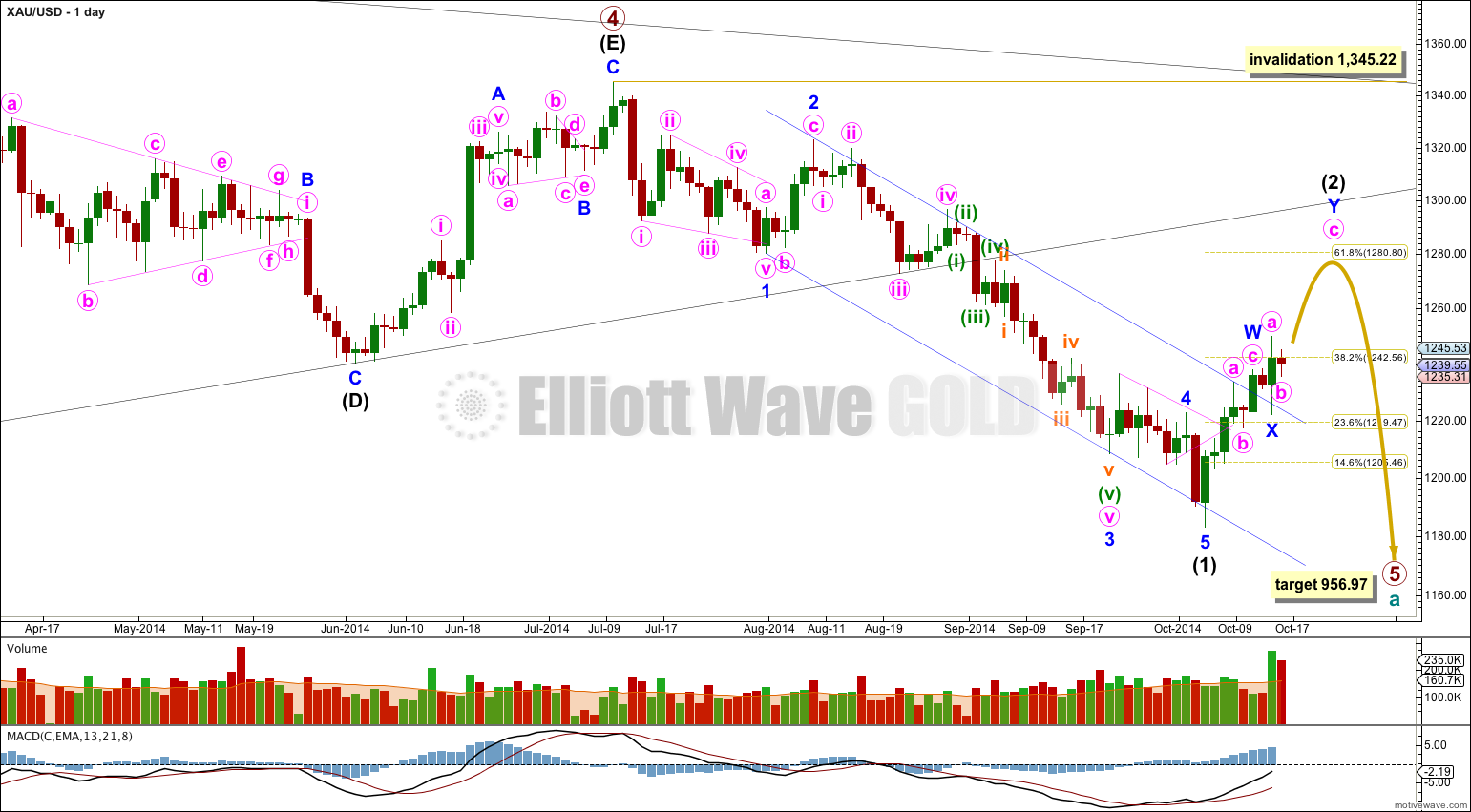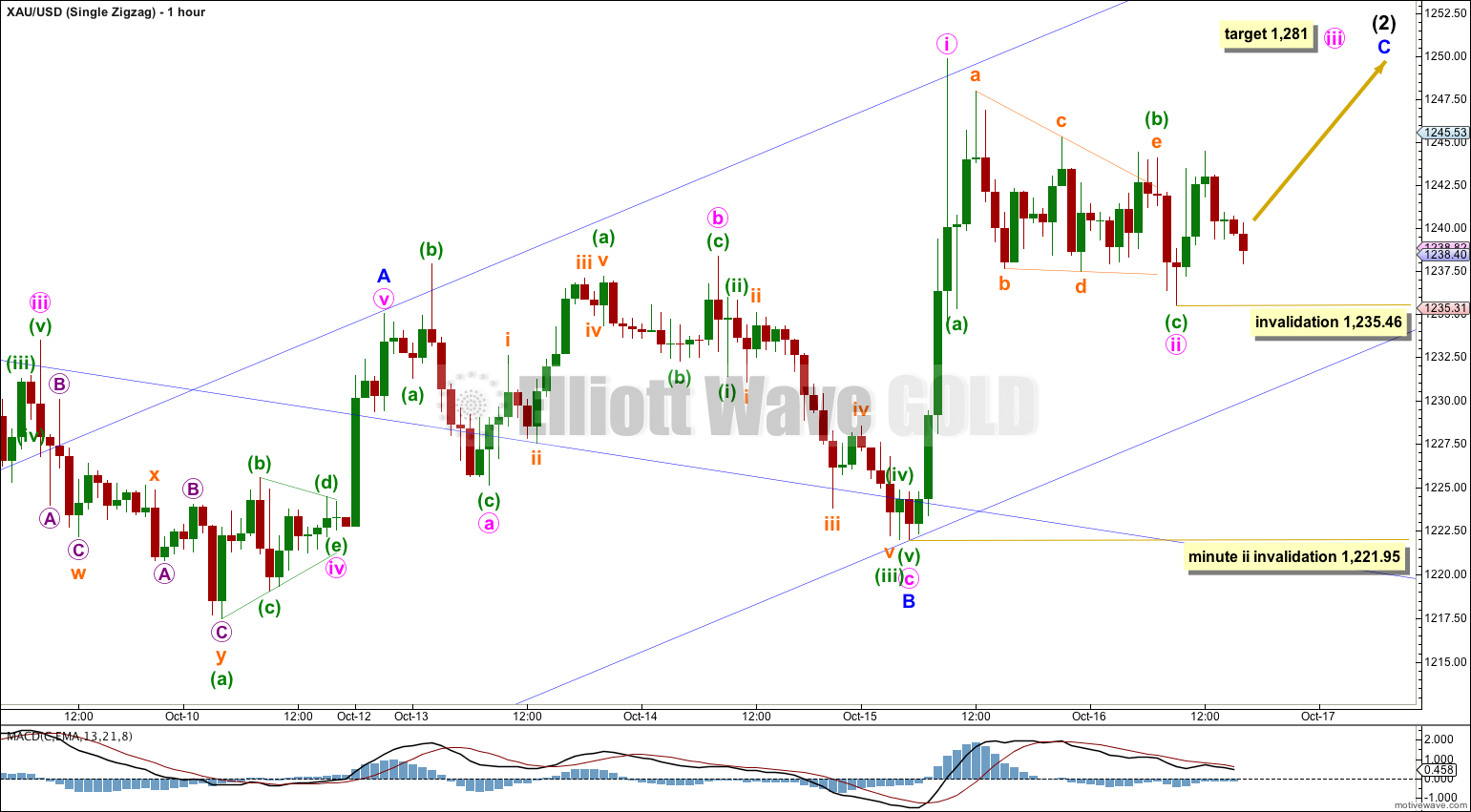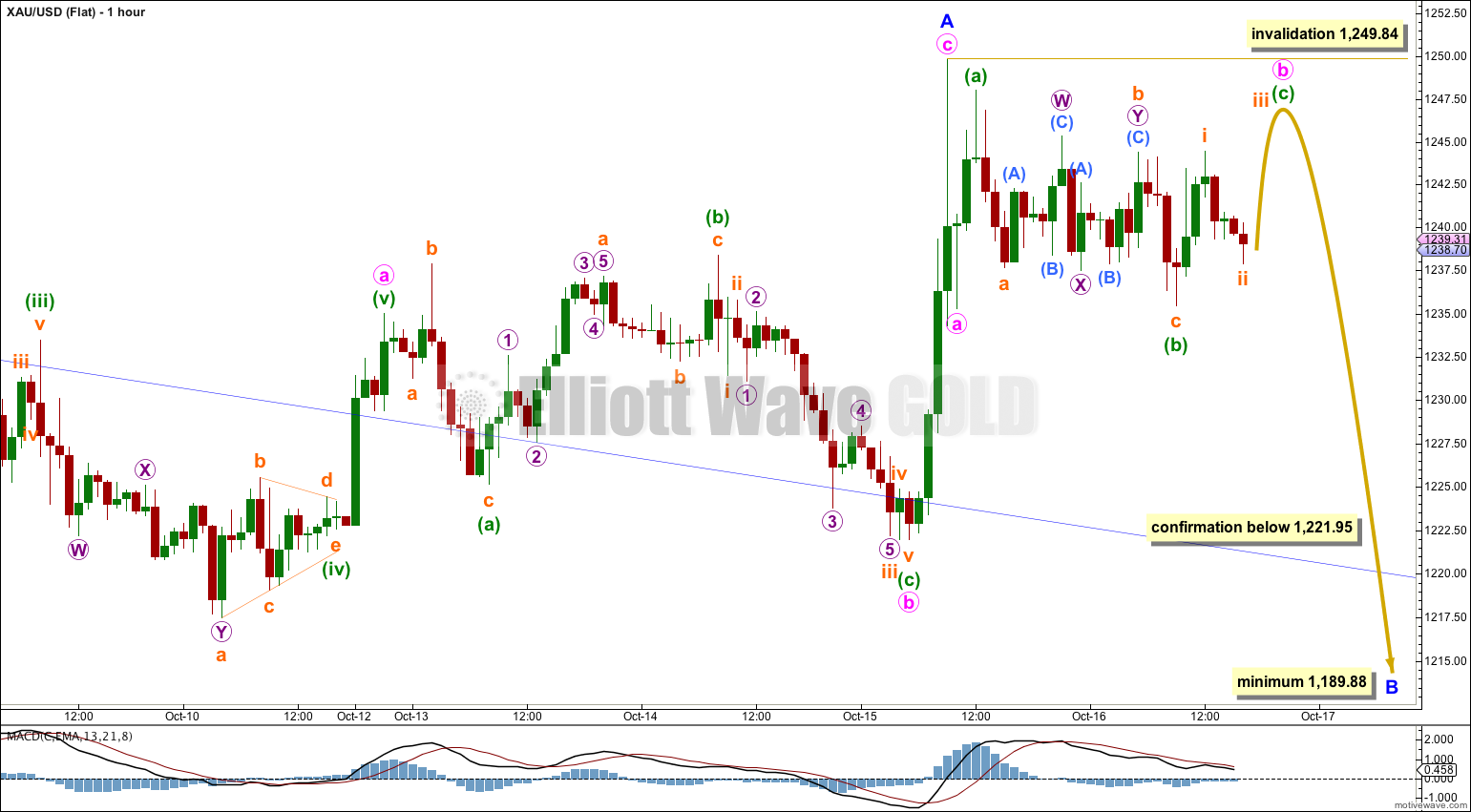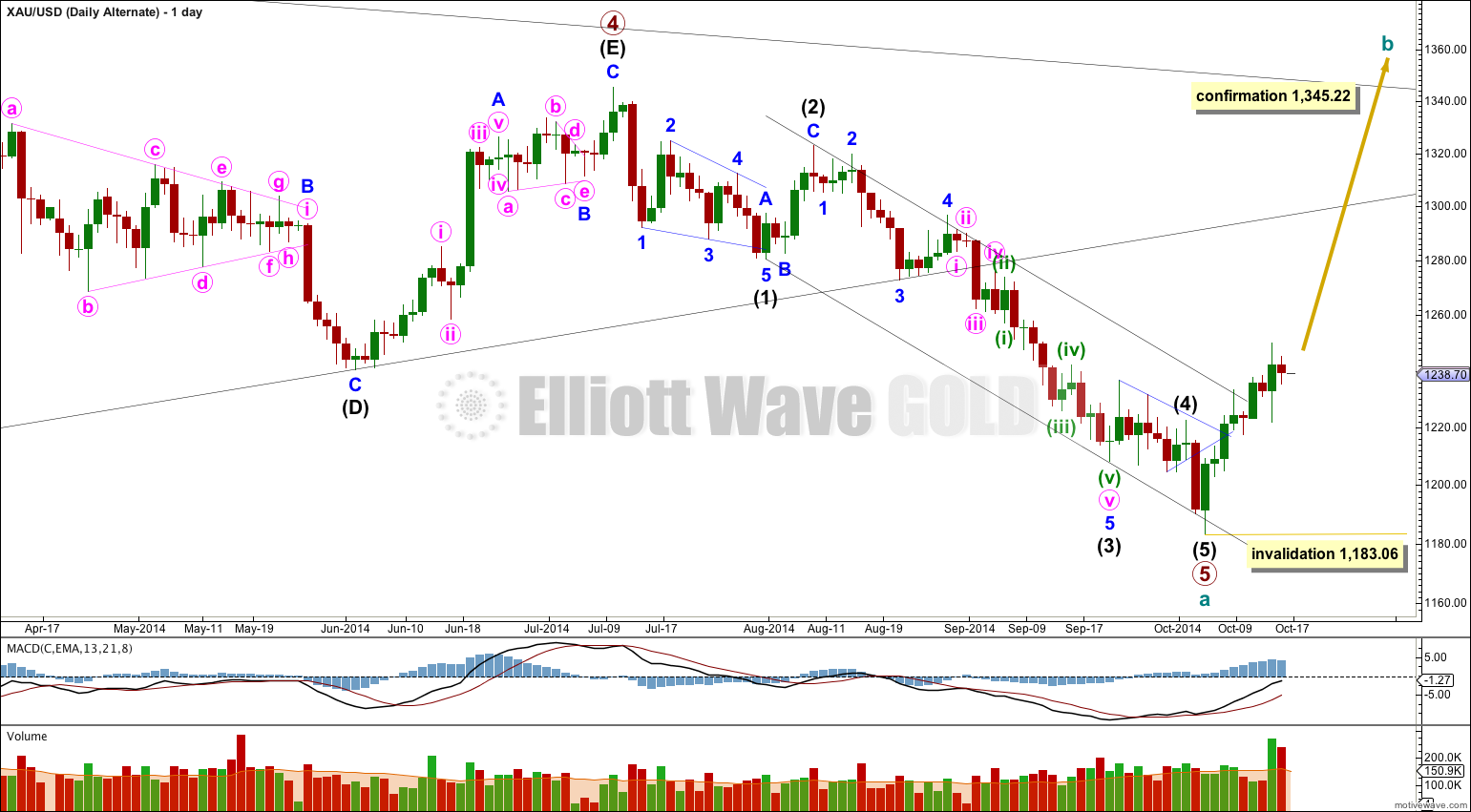The short term target for a little downwards movement was at 1,232. Price moved mostly sideways, and slightly lower, falling 3.46 short of the target and taking longer to do so than expected.
Summary: Upwards movement is incomplete. At this stage I expect it is quite likely to end about 1,281, in about one week.
Click on charts to enlarge.
Main Wave Count
On the weekly chart extend the triangle trend lines of primary wave 4 outwards. The point in time at which they cross over may be the point in time at which primary wave 5 ends. This does not always work, but it works often enough to look out for. It is a rough guideline only and not definitive. A trend line placed from the end of primary wave 4 to the target of primary wave 5 at this point in time shows primary wave 5 would take a total 26 weeks to reach that point, and that is what I will expect. Primary wave 5 is in its 14th week.
At 956.97 primary wave 5 would reach equality in length with primary wave 1. Primary wave 3 is $12.54 short of 1.618 the length of primary wave 1, and equality between primary waves 5 and 1 would give a perfect Elliott relationship for this downwards movement.
However, when triangles take their time and move close to the apex of the triangle, as primary wave 4 has, the movement following the triangle is often shorter and weaker than expected, and this is my main reason for presenting the alternate wave count to you. If the target at 956.97 is wrong it may be too low. In the first instance I expect it is extremely likely that primary wave 5 will move at least below the end of primary wave 3 at 1,180.40 to avoid a truncation. When intermediate waves (1) through to (4) within primary wave 5 are complete I will recalculate the target at intermediate degree because this would have a higher accuracy. I cannot do that yet; I can only calculate it at primary degree.
Movement comfortably below 1,180.84 would provide further confidence in this main wave count as at that stage an alternate idea which sees primary wave 4 as continuing as a barrier triangle would be invalidated. I am not publishing this alternate idea as a chart because it has an extremely low probability.
Draw a channel about intermediate wave (1): draw the first trend line from the lows labeled minor waves 1 to 3, then place a copy on the high labeled minor wave 2. The slight overshoot of the lower edge of this channel indicates minor wave 5 may be over there. Intermediate wave (2) has just breached upper edge of this channel, and this trend line is now providing support.
Intermediate wave (2) may end close to a Fibonacci ratio of intermediate wave (1). Only because second waves are more commonly deep than shallow is the 0.618 ratio at 1,280.80 slightly favoured. But it does not have to be this deep.
At this stage I have three hourly wave counts for you which look at three different corrective structures for intermediate wave (2). I present them in order of probability: a double zigzag is most likely, followed by a single zigzag, and last a flat correction. I have changed the wave count for the flat correction idea, but it still has a very low probability.
Double Zigzag or Double Combination
It is most likely that intermediate wave (2) is unfolding as a double zigzag.
The first zigzag in the double labeled minor wave W is complete. All the subdivisions for this wave count fit perfectly. Minor wave W fell short of the 0.382 Fibonacci ratio of intermediate wave (1) and so it may be expected that a second zigzag is required to deepen the correction.
Minor wave X is a complete three in the opposite direction joining the two zigzags in the double. Minor wave X subdivides perfectly as an expanded flat correction. It is a shallow correction, typical of an X wave within a double zigzag.
Minor wave Y has begun. I am now labeling minute waves a and b within it as complete because the sideways movement for minute wave b is long lasting and shows up on the daily chart.
Minute wave b subdivides very well as a complete zigzag with a barrier triangle in the middle for minuette wave (b). Minuette wave (c) is very slightly truncated. As this is a movement following a barrier triangle the truncation may be explained by the tendency of movements following barrier triangles to be remarkably brief.
Within double zigzags sometimes (often?) we see alternation between each zigzag. Within minor wave W minute wave a is longer than minute wave c: minute wave c is just 0.61 longer than 0.236 the length of minute wave a. We may see alternation between the length of the A and C waves of these two zigzags. Minor wave Y may show a shorter minute wave a and a longer minute wave c. At 1,281 minute wave c would reach 1.618 the length of minute wave a. This is also the 0.618 Fibonacci ratio of intermediate wave (1)
This is an illustration of the flexibility required when applying the guideline of alternation.
Within minute wave c no second wave correction may move beyond the start of its first wave below 1,235.46.
If 1,235.46 is breached then it is possible that minute wave b is continuing further as a double zigzag or double combination. Downwards movement should find support at the lower edge of the best fit channel drawn about intermediate wave (2).
Draw the channel from the start of intermediate wave (2) at 1,183.06 (now off to the left of the chart) to the low of minor wave X. Place a parallel copy on the high of minute wave a within minor wave W.
If minute wave b continues further it may not move below the start of minute wave a below 1,221.95. I would expect it is most likely that minute wave b is over now.
Single Zigzag
It is possible to see upwards movement as a five wave impulse complete at the high labeled minor wave A, but the subdivisions do not have quite as good a fit as the first double zigzag hourly wave count. This single zigzag hourly wave count has a slightly lower probability.
If minor wave C upwards is to subdivide as a five wave structure then within it minute waves i and now ii are most likely complete. This wave count expects to see an increase in upwards momentum over the next 24 hours as a third wave up unfolds. At 1,281 minute wave iii would reach 1.618 the length of minute wave i.
This wave count has the same target and invalidation points as the first wave count. The lower edge of the channel is drawn in exactly the same way.
When minute waves iii and iv are complete I would then calculate a target for minute wave v to end minor wave C.
Flat
This wave count is now mostly the same as the single zigzag wave count above; I have simply moved the degree of labeling within minor wave A down one degree. This five wave impulse may be only minute wave a within a zigzag for minor wave A.
Several problems of my previous flat correction wave count are now resolved.
However, current sideways movement does not fit as well for this wave count. This movement is still seen as a b wave at minute degree, but in the opposite direction. Within it minuette wave (b) does not fit as a triangle, but it does fit as a double combination. The problem is that minuette wave (c) is most likely not over, as to label it complete would see it significantly truncated. Minuette wave (c) would be most likely to end at least slightly above the end of minuette wave (a) at 1,247.99 to avoid a truncation.
When minute wave b is complete then I could calculate a target for minute wave c downwards.
When minor wave A subdivides as a three then intermediate wave (2) may be a flat correction. Within a flat minor wave B must make a minimum 90% correction of minor wave A at 1,189.88 or below. Minor wave B may make a new low below the start of minor wave A at 1,183.06.
If price breaks below 1,221.95 then this would be my only hourly wave count. At that stage I would expect more downwards movement to at least 1,189.88.
Alternate Wave Count
By simply moving the degree of labeling within primary wave 5 downwards all up one degree it is possible that primary wave 5 and so cycle wave a are over.
This wave count is reduced in probability by a small truncation. Primary wave 5 would be truncated by $2.66. The truncation is small though, so this wave count must be considered.
Movements out of triangles are often more brief and weak than expected, sometimes they are surprisingly brief.
If price breaks out of the upper edge of the parallel channel about cycle wave a (look to the weekly chart for this channel) this would be first indication that this wave count is correct. This trend channel confirmation would come before price confirmation above 1,345.22.
The first movement upwards for cycle wave b should be a five wave structure. Within it no second wave correction may move beyond the start of its first wave below 1,183.06.
Movement above 1,345.22 would invalidate the main wave count and confirm this alternate.
At this stage upwards movement is not looking like an unfolding impulse, and so this alternate wave count is further reduced in probability.
This analysis is published about 05:41 p.m. EST.





